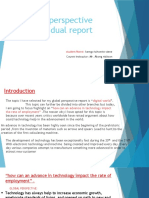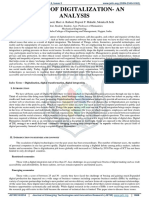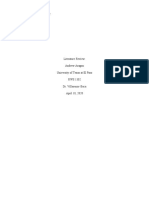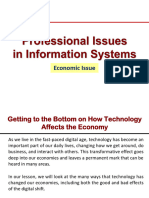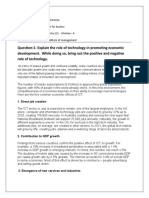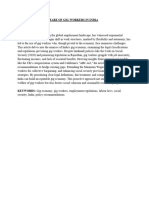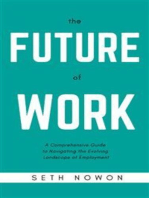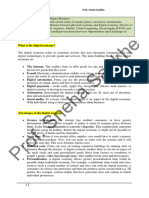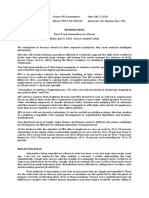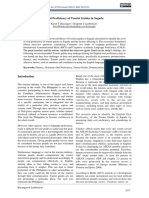Templete For GD Report
Templete For GD Report
Uploaded by
Shush SinghCopyright:
Available Formats
Templete For GD Report
Templete For GD Report
Uploaded by
Shush SinghOriginal Description:
Original Title
Copyright
Available Formats
Share this document
Did you find this document useful?
Is this content inappropriate?
Copyright:
Available Formats
Templete For GD Report
Templete For GD Report
Uploaded by
Shush SinghCopyright:
Available Formats
GROUP DISCUSSION 2019
TOPIC 1
MERITS & DEMERITS OF CASHLESS ECONOMY
A cashless society is not one where no money changes hands. Instead, it involves transferring funds
via digital methods. In essence, money is represented electronically. There are people on both sides of
the issue and the debate continues regarding whether a cashless economy is beneficial or not. If you’d
like to know more about the issue so that you can decide what side you’re on, here are the pros and
cons of a cashless economy.
One of the primary benefits of a cashless economy is there won’t be as many currency notes in
circulation. This is good because it reduces the risk of theft and ensures that individuals and
businesses have access to their money when they need it. At the same time, it saves the government
money because they won’t have to pay to have currency minted. Some experts say this could translate
to lower taxes for people.
In addition, a cashless economy cuts down on the number of people who aren’t paying their taxes.
When transactions are made online, the government is better able to keep track of what people are
earning or spending so that proper taxes can be charged and collected.
Finally, eliminating the use of currency helps limit corruption in terms of welfare. When there is no
actual cash on hand, corrupt officials cannot gain access to it or steal it. People who are on welfare or
other governmental assistance don’t have to worry that their funds won’t be available when they are
needed.
There are definitely perks to a cashless economy, but there are also several drawbacks. One of the top
concerns is that there aren’t too many people who are educated on how a cashless economy works.
This is especially true in developing nations where a cashless economy would be most helpful. Before
such a system can be instituted, citizens must be taught how to use it so that everyone can benefit.
At the same time, in places where the internet connection isn’t good, only being able to make
transactions online can be problematic. If payment can’t be made, people will have trouble making
purchases and paying bills.
Some people are against the system because they don’t want to have their money held in banks. Some
prefer to use cash or checks and don’t want to be told how to manage their funds or where they must
keep them. In that regard, a cashless economy can be seen as a loss of freedom.
Department of Mechanical Engg, Nagarjuna College of Engg and Technology, Bengaluru 1
GROUP DISCUSSION 2019
Finally, some people aren’t worthy of having access to this kind of credit. Some individuals will
abuse the system, which could cause repercussions for others since money will be lost. When credit is
given to people who don’t use it properly, the average taxpayer is usually responsible for paying the
tab.
There are clearly a wide range of perks and drawbacks to a cashless economy. While it is certainly
something that may happen at some point, at the present time, the benefits don’t outweigh the
drawbacks and many countries aren’t prepared to institute such a system. That doesn’t mean it won’t
happen someday, but it’s not a completely foolproof system as yet and will require some
consideration before it can be used in a widespread sense.
Merits:
High availability (24*7 hours)
Reduce time and resources
Easiness of fund transfer
Free from the long queue
Don't stress yourself, Pay on the Web itself
Easiness of paying bills e.g. electricity, water, shopping bills etc
Portable economy (Access of money at any time on anywhere)
Control on corruption to some extent
Saves paper and pen
Demerits:
High internet connectivity is required to do successfully transactions
Awareness is required- how to use the digital platform securely
Be aware of fraudulent emails and phishing (spoofed) websites
Don't waste paper!
Go paperless!
Go cashless!
TOPIC 2
IMPACT OF TECHNOLOGY ON JOBS
Department of Mechanical Engg, Nagarjuna College of Engg and Technology, Bengaluru 2
GROUP DISCUSSION 2019
Technology for anything is the advancement of the current processes for given task. When we talk
about technology in jobs we mean how automated a work can be, so that it increases the efficiency
and enables cost reduction. In the name of effectiveness and efficiency machines have overpowered
human effort in many sectors, and will continue to do so. What’s important is to know that technology
upgrade has two aspects on jobs is that how is has helped in making the job the employees easier and
the other is how it has reduced the number of jobs available or negative impact on the jobs.
How technology has reduced jobs?
The major positive impact of technology is that is has lesser chances of errors , as compared to the
human toil, and this could soon lead to most of the work of labour into AI (artificial intelligence)
based systems of organization and mass production, mostly of the manufacturing and the agriculture
sector .
Automation of not only the mundane tasks but also professional work performed by the highly
paid workers, if the work being done by software leads to precise results saving money and
time. The firm will end up needing less labour.
Moreover, all workers will need to adapt, as their occupations evolve alongside increasingly
capable machines in order to work and earn. The pace of modern technological change is so
rapid that many workers, unable to adjust, will simply become obsolete.
The more and more technological aided work will lead to lesser labour , from the
manufacturing to tertiary every sector will contribute to the reduced demand of labour. For
example consider India a labour intensive country, if we adapt to capital intensive methods of
production, the time will soon come when there are masses on road, demanding jobs. Hence,
we should think of new ways to employ more and more labour rather than capital.
Arguments that Jobs will be increased due to technological advancements
According to a research this automation will lead to more increase in jobs than it will
ever decrease. When Rajiv Gandhi was the Prime Minister he proposed to bring computer to
India, he faced backlash from people that this will lead to decrease in employment, however,
exactly the opposite happened.
It is widely suggested that that workers will have greater employment opportunities if their
occupation undergoes some degree of computer automation. As long as they can learn to use
the new tools, automation will be their friend. For example - when ATMs automated the tasks
Department of Mechanical Engg, Nagarjuna College of Engg and Technology, Bengaluru 3
GROUP DISCUSSION 2019
of bank tellers and when barcode scanners automated the work of cashiers, rather than
contributing to unemployment, the number of workers in these occupations grew.
With advent of new technologies industry experts see the need for skilled workers increasing
in the short run and persisting for at least another decade. The experts call for training
programs with a new curriculum and certifications to standardize emerging job classifications.
Enabling more people to harness the benefits from technological advancements is in the best interest
of any business or country. Continuous investment in technology without considering the impact on
existing workforce could result in a host of other problems.
For a current shift from lack of conviction towards new technology to skilled workforce initiatives
like better retraining for workers who have lost their jobs to automation, and increased financial
protections for those seeking new careers, are the recommended steps.
Impact of technology depends on kind of technology is being adopted by the organization. I believe
good technology will be consider if its generate more revenue as well as generate more employment.
If you totally depend on technologies initially it will lead to cost effective but if any change is
required as per the market conditions then change in technology may be a costly affairs. On other
hand if you make a balance between technology and human interventions one will easily and swiftly
adopt the changes in market as per the customer demands. But it is also true Robotics and AI will
make drastic changes in technology which will make major impact in upcoming job more and more
people have Robotics and AI skilled will be required.
Positive impact:
Reduces workload.
Better quality.
Easy to use.
Negative impact:
Increases unemployment.
Difficult to use.
Department of Mechanical Engg, Nagarjuna College of Engg and Technology, Bengaluru 4
GROUP DISCUSSION 2019
TOPIC 3
MAKE IN INDIA V/S MAKE FOR INDIA
Just in time when people are growing restless of the “only talks and no action” strategy of the BJP
government led by Modi who promised “acche din” for people along with bringing back of black
money within 100 days, questions have been raised on his “make in India” policy. Reserve Bank of
India governor Raghuram Rajan, who also happens to be a former chief economist at International
Monetary Fund raised concern over the manufacturing centered policy of the government. He also
criticized that the focus should be on “make for India” instead of “make in India.” Should
government take Rajan’s advice seriously or continue with its own plans?
Drawbacks of the “make in India” policy:
1. The policy of ‘make in India’ is simply a replication of the Chinese policy. Following this policy
might not work the same way as it did for China. India has a different kind of economy and is
developing at a different time, and we should be wise while framing policies about what will work for
us.
2. This campaign is focused only on the manufacturing sector. As pointed out by Rajan there is
“danger when we discuss Make in India as something which is focused on manufacturing, an attempt
to follow the export-led growth path that China followed.”
3. If India pushes manufacturing exports, it will have to compete with China which is the leading
player in the international market and an export-led growth will not be the same as it was for the
Asian economies that followed the strategy before.
4. An export led strategy would involve subsidizing exporters with cheap inputs as well as an
undervalued exchange rate, and this would simply be ineffective at this juncture. India, at the verge of
development needs policies that would ensure growth for its people.
5. According to Rajan, ‘this strategy has been tried and it has not worked because it ended up
reducing domestic competition, making producers inefficient, and increasing costs to consumers.’
Why is the government bent on repeating the same mistake twice?
6. Instead of export, India needs to focus on domestic demand and create an integrated market with a
view to reduce transactions cost. The policy lacks this point of view which is essential for the internal
growth of India and the policies meant for development must be framed keeping these in mind.
Department of Mechanical Engg, Nagarjuna College of Engg and Technology, Bengaluru 5
GROUP DISCUSSION 2019
Advantages of “make for India” policy:
1. Improvements in the physical transportation network will help and internal growth will be seen for
the people of our country.
2. A well designed GST bill should be introduced by reducing state border taxes. This will reap the
much needed consequence of creating a truly national market for goods and services, which will be
significant for our growth in years to come.
3. Government needs to valve the domestic demand strength instead of investing in a duplicate China-
like export-led policy in a slowing and uncertain world. This policy might prove to be beneficial
when implemented a few years from now but currently the call is for internal growth.
4. The country needs to pay attention to regional and domestic demand for our growth. When the
entire country is malnourished and poverty ridden, there cannot be growth via export sector. To make
in India, it is essential that steps be taken in favor of internal growth.
5. Government should work on creating the strongest sustainable unified market that can be created,
which requires a reduction in the transactions costs of buying and selling throughout the country. The
promise of ‘acche din’ was addressed for the common people of India too and not just for
industrialists in India.
6. Instead of subsidizing inputs to specific industries because they are deemed important or labor
intensive, a strategy that has not really paid off for the country over the years, the government must
try to figure out the public goods each sector needs, and strive to provide them.
Hence we can conclude that “the ‘make in India’ policy might be a smart move towards making India
a developed nation in every field of development but that can only be possible if the internal demands
of people are met as per the promises made by the government before coming to power. We do
understand that it is not a matter of few days to bring good times in a nation facing so many
challenges but every policy designed towards the betterment of the nation should also include areas of
benefit for the common people of the country. A balanced mix of ‘make in India’ and ‘make for
Department of Mechanical Engg, Nagarjuna College of Engg and Technology, Bengaluru 6
GROUP DISCUSSION 2019
TOPIC 4
WHICH IS MOST IMPORTANT- CREATIVITY OR
EFFICIENCY
“Creativity is the use of imagination or original ideas to create something; inventiveness” .
OR
“Efficiency is the ability to avoid wasting materials, energy, efforts, money, and time in
doing something or in producing a desired result. In a more general sense, it is the ability
to do things well, successfully, and without waste”.
In the 21st century, creativity, specifically in the business & start-up world, isn’t just synonymous to
being artistic. Rather, I’d say the term innovative is much closer. Creativity implies how well you
come up with new fixes, hacks, solutions to old problems. How you visualize answers to questions
which have gone unanswered, even unobserved. Creativity isn’t just the mouthpiece of the painter,
the dancer or the writer, but equally so of every agile, logical and solution-driven individual,
especially where the problem-solver angle is concerned.
A classic case that comes to my mind is that of Uber. As an idea- it seems pretty simple. A tech-driven
aggregator for on-demand taxis. Yet, an uncomplicated idea that revolutionized taxi travel across the
globe. But if it really was so easy, why didn’t we all think of it? A similar case with AirBnb. A
platform to allow people to rent out their homes, when they’re vacant, and make some money on the
side, another opportunity few people recognized. And why didn’t we observe it, when the problems at
hand weren’t exactly hidden, but visible for everyone to actively notice?
Efficiency, which when mentioned in business context denotes organization, orderliness, planning,
regulation and orderliness. In my eyes, Efficiency is the key driver of the process without which
moving ahead is impossible. Creativity, however, is the initiator “the solution-driver”. The idea-
generator the newer, different path to what may be possibly be the same destination. It may sound like
a chicken-and-egg situation, but I’d say that creativity precedes efficiency, as the starter of the cycle
of change.
Additionally, makes creativity so special is that at least today, unlike efficiency, it can’t be automated.
Creativity still remains a premium quality of the human brain. And fortunately, for creative
individuals, there’s never been a better time to add value to business processes. As Design thinkers, as
Department of Mechanical Engg, Nagarjuna College of Engg and Technology, Bengaluru 7
GROUP DISCUSSION 2019
Storytellers, as Content-creators, and lots more- Creative wandering, out-of-the-box thinking
minds, not always bound my logic, analysis and reason. And something tells me that this appreciation
of human creativity only just started.
Creativity deals with generation of new ideas. Efficiency is concerned with getting the maximum out
of minimum. Unlike creativity, efficiency can be expressed as a ratio between output and input. In
turbulent times like these when rate of change is faster, creativity is more important. In relatively
stable times when rate of change is very slow, efficiency is more important.
In the context of a startup, creativity will be more important than efficiency in the beginning. Once
the startup begins to gain stability in areas like market share, revenues, product offerings etc, it turns
to efficiency.
Interestingly, creativity and its close cousin lateral thinking are way less efficient than logical
thinking.
It totally depends on what work you are doing. For example if you have to do something in bulk in
less time than you would probably think about efficiency and go with clichéd ideas. While, if you
have to do just one project and you are not given any deadline for it then you would think of being
creative.
Creativity is better but when you have enough time to think while being efficient is good given time
constraints. It affects and effects the way you think, while efficiency is a process that can easily be
leaned. However both are necessary in life.
Creativity allows you to think out of the box, find solutions to problem not thought of previously, and
efficiency allows you to implement those solutions for a successful outcome.
Department of Mechanical Engg, Nagarjuna College of Engg and Technology, Bengaluru 8
GROUP DISCUSSION 2019
TOPIC 5
PRESENT EDUCATION SYSTEM IN INDIA
Education in India is provided by public schools (controlled and funded by three
levels: central, state and local) and private schools. Under various articles of the Indian Constitution,
free and compulsory education is provided as a fundamental right to children between the ages of 6
and 14. The approximate ratio of public schools to private schools in India is 7:5.
India has made progress in increasing the attainment rate of primary education. In 2011,
approximately 75% of the population, aged between 7 to 10 years, was literate. India's improved
education system is often cited as one of the main contributors to its economic development. Much of
the progress, especially in higher education and scientific research, has been credited to various
public institutions. While enrollment in higher education has increased steadily over the past decade,
reaching a Gross Enrollment Ratio of 24% in 2013, there still remains a significant distance to catch
up with tertiary education enrollment levels of developed nations, a challenge that will be necessary
to overcome in order to continue to reap a demographic dividend from India's comparatively young
population.
At the primary and secondary level, India has a large private school system complementing the
government run schools, with 29% of students receiving private education in the 6 to 14 age group.
Certain post-secondary technical schools are also private. The private education market in India had
revenue of US$450 million in 2008, but is projected to be a US$40 billion market.
As per the Annual Status of Education Report (ASER) 2012, 96.5% of all rural children between the
ages of 6-14 were enrolled in school. This is the fourth annual survey to report enrollment above
96%. Another report from 2013 stated that there were 229 million students enrolled in different
accredited urban and rural schools of India, from Class I to XII, representing an increase of 23 lakhs
students over 2002 total enrollment, and a 19% increase in girl's enrollment. While quantitatively
India is inching closer to universal education, the quality of its education has been questioned
particularly in its government run school system. While more than 95 percent of children attend
primary school, just 40 percent of Indian adolescents attend secondary school (Grades 9-12). Since
2000, the World Bank has committed over $2 billion to education in India. Some of the reasons for
the poor quality include absence of around 25% of teachers every day. States of India have introduced
tests and education assessment system to identify and improve such schools.
Department of Mechanical Engg, Nagarjuna College of Engg and Technology, Bengaluru 9
GROUP DISCUSSION 2019
Although there are private schools in India, they are highly regulated in terms of what they can teach,
in what form they can operate (must be a non-profit to run any accredited educational institution) and
all other aspects of operation. Hence, the differentiation of government schools and private schools
can be misleading.
In January 2019, India had over 900 universities and 40,000 colleges. In India's higher education
system, a significant number of seats are reserved under affirmative action policies for the historically
disadvantaged Scheduled Castes and Scheduled Tribes and Other Backward Classes. In universities,
colleges, and similar institutions affiliated to the federal government, there are a maximum 50% of
reservations applicable to these disadvantaged groups, at the state level it can vary. Maharashtra had
73% reservation in 2014, which is the highest percentage of reservations in India.
Positive side of Indian Education system:-
Students go through many exams in their learning years. It teaches to analyze our strengths
and weaknesses consistently.
Indian education system emphasizes competitive spirit. Competition teaches students to
unleash their full potential.
Indian schools teach basic knowledge in all subjects.
Annual system in school years helps slow learners.
These days a lot of positive changes are happening in the education system of India. Emphasis
on practical knowledge is increased.
Drawbacks of Indian Education system:-
Rote learning. Emphasis on memorizing the facts rather than thoroughly understanding the
concepts.
Completely relying on text books.
Giving more importance to text books than the teacher. There is no autonomy to teachers.
Students have no freedom to think creatively and to question the content in the text books.
Taking marks as assessment of student’s talent, when marks can be easily obtained by
memorizing the pre-written answers from the text books.
Students are not being taught why they are learning the particular subjects and topic. Text
books do not mention how the topics are relevant in the practical life.
There is no incentive for teachers to encourage critical thinking in children.
Department of Mechanical Engg, Nagarjuna College of Engg and Technology, Bengaluru 10
GROUP DISCUSSION 2019
Lack of infrastructure.
Most of the syllabus is in theoretical form.
Dearth of capable teachers in government schools.
Low salaries of teachers.
Pressurizing students for marks and grades. Student suicides are increasing day by day.
Students are teaching the subjects just to reach to the next level, i.e. obtaining admission from
the good college.
Indian govt is spending only 3% of its GDP on education.
As the Govt unable invest enough in the education sectors, private institutions roped in, and
the result is High cost of education.
No control of govt on fee structure of private educational institutes.
Ethics aren’t being taught in schools. And the result of this is many educated persons lack
ethics.
Very low teacher to student ratio. As a result, teachers are not able to concentrate on each and
every child. According to Right to Education, there should be one teacher for every 30
students.
High prices of higher education in India. Indian Govt isn’t investing in the higher education
aspirants.
Rise of coaching centers for competitive exams and private tuitions for school children are is
resulted by the poor education system, which couldn’t make students job-ready.
Our text books do not mention the importance of physical activity and the extracurricular
activities. Most of the schools in India do not have play grounds.
Not encouraging research and innovation.
Not teaching students about how to deal with daily life struggles.
Incentivizing hyper-competitiveness rather than encouraging to co-learn.
Shortage of text books for govt school students.
No proper career guidance available for students.
Most of the govt school students are unable to do basic math. This reveals the negligence of
teachers.
Not everyone has access to school. A lot rural areas still have no schools. And there are many
single teacher schools.
In the top 100 universities list by ‘Times Higher Education World Reputation Rankings 2016’,
none of the Indian universities could make into the list.
Department of Mechanical Engg, Nagarjuna College of Engg and Technology, Bengaluru 11
GROUP DISCUSSION 2019
What Indian Government is doing:-
The ‘National Policy on Education’ was framed in 1986 and was amended in 1992.
New Education Policy (NEP) is going to be formed in 2016 to bring revolutionary changes in
Indian education system.
Rashtriya Madyamika Abhiyan, 2009 – This scheme aims to enhance access to secondary
education and to improve its quality.
Vidyanjali scheme, 2016 – to encourage extracurricular activities in students.
Rashtriya Uchchatar Shiksha Abhiyan (RUSA), 2013 – A mission to finance massively in
state universities. But this wasn’t successful as expected.
What still needs to be done:-
Indian Govt needs to invest heavily in infrastructure, teachers and in training teachers. At least
4% of its GDP must be invested in the education sector.
Our attitude towards marks and grades needs to be changed.
Method of teaching needs a relook. Teachers should encourage logical thinking & creativity in
students. “Tell me and I forget, teach me and I remember, involve me and I learn.”―
Benjamin Franklin
Exams should be in a way that student’s understanding of the subject can be assessed.
Students should be exposed to economic and societal problems in the world.
Self help books and biographies of successful persons should be a part of the syllabus. So that
children can mould their personalities and can handle stress well, once they start career.
Malnutrition effects child’s ability to learn. So, nutritional deficit must be taken care of..
Conclusion:-
There is a dire need for revolutionary changes in the India’s education system. Not just the
syllabus and pedagogy, but also the attitude change towards the marks system need to be changed.
With the effective learning system, India can successfully utilize its vast human resources.
Department of Mechanical Engg, Nagarjuna College of Engg and Technology, Bengaluru 12
GROUP DISCUSSION 2019
TOPIC 6
WHICH IS IMPORTANT- HARD WORK OR SMART WORK
Work is important to do as it takes us to the next level of success. The most important question you
should ask at this place is what kind of work will take you to that level: is it hard work or smart work.
Hard work is the only key to achieving it; it teaches us discipline, dedication and
determination. Hard work is definitely more important because it is only through hard work that
we can achieve the goals of our life. Smart work, on the other hand, often leads to shortcuts and
procrastination.
Combination of hard work and smart work is the best recipe for success. Hard work calls for
dedication and discipline, keeping you consistent along the way. Smart work adds a flavor of ex-
factor which quickens success rate. Missing any one of them wouldn't bestow the desire result. In the
wake of brisk pace world, smartness can't be bargained. Skills are sharpened with consistent hard
work and application of skills at the right time and place is smartness. Life is full of opportunities,
smart people can identify them quickly and reap success applying hard and soul. Hard work & smart
work both are very important in their own state. We can't achieve success by leaving any of them. But
in fact smart work is very much better than doing hard work but it is not necessary to exclude hard
work for going to the next level for getting the goal of success. In many cases we have to do hard
work excepting smart work because hard work gives more knowledge about what you are doing with
the help of hard work. So we have to own these two types of work for getting success. These two are
mostly needed for going to the next level of the job you are doing.
Many people work very hard, but only a few become really successful. That’s because working hard
simply not enough. You have an extremely limited amount of time for work every day and there’s
always someone prepared to sleep less than you are. That’s why you also need to work smart, very
smart. Most people who already work really smart have usually their character to thank, because they
know how to do it intuitively. It’s part of who they are. Nevertheless, those people are very rare, “one
in a hundred”. Everyone else who wants to work smart have to learn how. It’s definitely worth it,
because smart work is the best way to advance your career and outperform all competition. Below,
you can find 30 elements of smart work, based on an extensive analysis of a few outliers that knew
how to work smart (not only hard) from the very beginning of their career, and also based on my own
experience and findings. To be honest, I used to be a hard worker only. Not anymore. If you
Department of Mechanical Engg, Nagarjuna College of Engg and Technology, Bengaluru 13
GROUP DISCUSSION 2019
implement half of these ideas into your own life, you will definitely become a much smarter worker
and unleash an entirely new level of your potential – for success and happiness.
The best type of work helps us in different ways in managing the job as:
1. From physical to creative work
The first element of smart work is pretty obvious, but very important. In the creative society, where
brains are respected, physical work has low value. Thus to be a really smart worker, you have to train
your brains constantly, the analytical as well as the creative part. You need to get skilled up, acquire
as much practical knowledge as possible, and take good care of your competences. As a smart worker,
you can never be overpaid, overdressed or overeducated (formally and informally). Smart workers
also understand the importance of soft skills like public speaking, sales, leadership etc., so they never
miss an opportunity to develop or improve them. Smart workers know that hard work will rarely
speak for itself.
2. Life management skills - health, wealth and relationships
Unfortunately, being intelligent and educated doesn’t necessarily mean making good decisions and
choices in life. Many very intelligent people are unhappy and stuck. That’s why smart workers
understand the importance of three essentials you have to take care of in life in order to work smart –
good health, sound wealth and strong relationships. The problem is that schools as well as parents
usually never teach a person how to take care of their health, manage money and develop capacity for
love. But these are the essentials that enable you to reach the highest grounds. If you want to be a
smart worker, you have to learn these three basic life management skills, because they give you more
options. Smart workers make sure they have many options in every single situation they face.
3. Time management skills
Smart workers understand that time is the most precious resource in life. Time is even more important
than money. That’s why smart workers value their time the most in life and they make sure that
they manage it very wisely. For smart workers, every single second counts.
That’s why they learn how to deal with procrastination, eliminate distractions, how to focus, work in
the flow, and so on. Smart workers definitely never lose time with supposedly important e-mails and
meetings.
Department of Mechanical Engg, Nagarjuna College of Engg and Technology, Bengaluru 14
GROUP DISCUSSION 2019
Understanding the system and the territory you operate in
The better you understand the system you operate in, the smarter you can work. Better understanding
the territory you operate in means you can make better decisions and manipulate the system to your
advantage; in a moral and legal way of course, while keeping your integrity intact. Formal education,
healthcare, politics, taxes, startups, investing, dating etc., everything is a system and understanding
the system helps you get to your goals faster and cheaper.
Knowing what you want
If you know exactly what you want, you can shape a much better strategy and make much better
choices in the process of meeting your goals. That’s what smart work is all about. You can’t work
smart if you don’t know what you want. That’s why you always have to start with a desired outcome
in mind. Smart workers know themselves really well and so they know what they want; and then they
fight for it. Start with a life vision.
Being in the right industry
Smart work means choosing the right industry or the right market, if you want. Markets are the one
thing that can put your career on the fast track or destroy it in the blink of an eye. If you operate on
the right market, you’re exposed to more business opportunities; you can earn a lot more money more
quickly, and so on. A rising tide lifts all boats. Smart workers don’t only think about what they want
(that is usually a very selfish perspective of hard workers), but also think about what markets want
and about market trends and paradigms they can benefit from.
Providing scarce skills to markets with a high demand for that skill set
As a smart worker, you want to be in a position where you’re exposed to many opportunities and
where you always have options. The best way to do that is by acquiring competences that are in great
demand, but in very short supply. Everybody knows how to use a copy-machine, but not many people
are exceptional programmers or leaders (both in short supply). On top of that, smart workers make
sure that they are the top performers in what they do. They understand that the top 20 % of people get
80 % of the rewards. Smart workers try to be superstars in what they do and let people know it.
Looking on the bright side of life
There’s not a single good thing that comes out of negative thinking, and that also includes preventing
you from doing smart work. Smart workers keep a positive outlook, no matter how difficult things
are. If you focus all your cognitive power on whining, complaining and feeling sorry for yourself, you
become blind to all opportunities you have, and you start lagging behind. If you want to work smart,
Department of Mechanical Engg, Nagarjuna College of Engg and Technology, Bengaluru 15
GROUP DISCUSSION 2019
you have to keep your mind open for improvements, creative ideas and new opportunities. The world
goes on, with you or without you. To look on the bright side of life you need a problem-solving
mindset.
Carefully selecting the right opportunities
A positive mindset leads to noticing many opportunities. So many, in fact, that you can drown in
them. Smart workers are aware that their time, energy and other resources are very limited, which is
why they choose their battles very carefully. Smart workers choose opportunities with low risk and
massive potential; and they learn to say no to everything else. Remember that a burnt-out worker,
worker who doesn’t know how to say no, is not a smart worker. Smart workers are also very patient
(being able to create or wait for the one right opportunity) and they definitely know how to mitigate
risks. Thinking and researching before acting.
Smart workers are aware that good preparation and staying flexible in the process can save a ton of
work later. An hour of planning, thinking and researching can save many hours in the execution
phase. Smart workers rarely say yes to opportunities, but when they do, they make sure to execute
with surgical precision. The quote “Success occurs when opportunity meets preparation” perfectly
suits this point.
TOPIC 7
IS SOCIAL MEDIA ACTUALLY CONNECTING PEOPLE
Social media is a tool of many uses. It has facilitated our lives in different ways, it has connected
people with their friends whom they thought were gone forever and they would never meet again, talk
again. It has given certain set of people a chance to find their love interests as well. It has empowered
common man, it is a vital tool for mass communication. Just a 140 character tweet can create such
huge impact. However, with all the benefits shines the other side of the coin. There have been cases
of misuses. People tend to write their views without knowing that they are hurting sentiments of
others. It has also clogged people from becoming outgoing. They stick to their smart phones and other
gadgets.
Department of Mechanical Engg, Nagarjuna College of Engg and Technology, Bengaluru 16
GROUP DISCUSSION 2019
Facts related to the topic
• Social media is the newest medium of networking, connecting and mass media
• It spans through to websites like Face book, twitter, Instagram to apps like WhatsApp, WeChat,
telegram etc., through blog posts to news websites
• There are just over 3 billion active Internet users (45% of the world’s internet users)
• Nearly 2.1 billion people have social media accounts
• 3.65 billion mobile users have access to the internet via smart phones and tablets
• Close to 1.7 billion people have active social media accounts
• In India mobile devices account for 72% of all web site traffic
• There are 1.65 billion active mobile social accounts globally
• 561 million active mobile social accounts are located in East Asia
• There are nearly 1.4 billion Face book users
• 47% of all Internet users are on Face book
• 4.5 billion likes are generated daily
• The fastest growing group of new users on Twitter is aged between 55 and 64 years old.
• 45% of users feel “worried or uncomfortable” when email and Face book are inaccessible
Pros of Social Media
One of the biggest pros of social media is that it nurtures and expands relationships. Improving
communication and strengthening human connection is the reason social media emerged. Facebook,
Twitter, Instagram, Pinterest, Snapchat, chat groups, LinkedIn, and countless other social networking
sites help people build on existing relationships, make new friends, and reinvigorate relationships that
have lapsed over time. Regardless of where a person lives, it’s possible to find others who share the
same interests and concerns. Social media has exponentially increased the resources for mental health
information and support. Research shows that people who get support from peers (those struggling
with the same problems) have better health outcomes, whether they have a physical condition like
diabetes or a psychological one like depression.
Department of Mechanical Engg, Nagarjuna College of Engg and Technology, Bengaluru 17
GROUP DISCUSSION 2019
Online support offers certain advantages that make it attractive to individuals who might not
otherwise seek help, for example:
1. Anonymity. Many people find it easier to share problems and feelings openly when there’s
minimal risk of identification or “real-life” consequences.
2. 24/7 availability. The internet never sleeps, and with the prevalence of cell phones, you don’t
even need to be home at your computer to access the resources you need. In the event of a crisis,
this can truly be life-saving; web-based support communities have been credited with saving
people from suicide and accidental drug overdoses.
3. No geographic limitations. Location can be an obstacle to participating in traditional support
groups that require physical attendance. Online groups pull members from all over and can host
larger numbers of people, adding to the pool of knowledge and experience.
Cons of Social Media
The very same attributes that make social media a positive force in our lives make it potentially
dangerous. For example, anonymity allows for cyber bullying. This is especially problematic for
teens, as bullies can target and prey on vulnerable high school peers without taking personal
responsibility. Stalking can also be an issue, as social media users sometimes post their whereabouts,
and their habits can be easily monitored.
Teens and young adults are considered particularly at risk to negative effects. They’re a generation
raised on the internet, social media, and digital technology so these things are integral, indispensable
parts of their lives. Young people also are impressionable, eager for acceptance, and relatively
inexperienced, which can cloud judgment. Most adults today remember what life was like before the
internet, social media, and mobile devices so it’s easier to step away from them. But it has still proved
problematic, especially for adults who are prone to addictive behavior or have pre-existing mental
health issues.
Social Media and Internet Addiction
Social media is addictive. Internet addiction is not officially listed in the Diagnostic and Statistical
Manual of Mental Disorders (DSM), the mental health profession’s guide to classifying psychological
disorders. However, in the recently revised DSM-5, “Internet Gaming Disorder” is mentioned as “a
Department of Mechanical Engg, Nagarjuna College of Engg and Technology, Bengaluru 18
GROUP DISCUSSION 2019
condition warranting more clinical research and experience” for possible inclusion as a “formal
disorder.” Lack of formal recognition hasn’t stopped people from referring to compulsive internet use
—for gaming or any other reason—as an “addiction.” Several recent studies seem to support this
conclusion, including brain imaging studies of compulsive internet users that have shown structural
and functional brain abnormalities similar to those found in people with substance abuse problems.
While it remains to be seen when and if Internet Addiction will make it into the DSM, the
characteristics of pathological internet use are very similar to the ones listed for “Substance-Related
and Addictive Disorders”:
Preoccupation with substance/activity
Use to improve one’s mood
Increasing tolerance (need to spend more time or take larger quantities to achieve same high)
Loss of other interests
Continued use despite awareness of the harm it’s causing
Withdrawal symptoms when the object of the addiction is no longer available
Unsuccessful attempts to quit
TOPIC 8
E- WORK MANAGEMENT
E-Work means that type of work performed through application of modern information and
communication technology, where the “e” stands for electronic, and electronic, literally, means
having to do with electrons. Electrons are the sub-atomic particles that move around us and give us
energy in the form of electricity. Work Management includes the integrated processes and
procedures that help the organization schedule work more efficiently, meet consumer’s needs, utilize
assets and evaluate performance.
Features of Work Management
Department of Mechanical Engg, Nagarjuna College of Engg and Technology, Bengaluru 19
GROUP DISCUSSION 2019
As an enterprise-wide process, Work Management standardizes the entry point of all ‘work’ done
within organization. Whether the work is capitalized or not, it will have a common origin, common
number used to track, and be traceable throughout the service Order and Cost Accounting Systems.
This allows for better customer services, estimates to actual comparisons, and more accurate bench-
marking. We can more readily attain the actual cost of work completed when there is commonality
through all systems. Customer contacts can be tracked by defined reason codes in the Contact
Tracking System, and provides a customized questionnaire and workflow for each contact reason.
Contacts can be recorded at the beginning or end of the contact, or automated as part of the standard
screen-flow when updating any screen. Customization is as simple as entering reference forms to
create service order types and contact tracking reasons, with customized task workflows built for
each. Task Workflows can be customized for screen entry flows, customized printed form outputs and
resources tasks.
A task-based design insures that jobs won’t fall through the cracks by utilizing a customized list of
steps or task, for each service order type or contact tracking reason established. A task duration setting
establishes normal response times for each task and summarizes the task duration to provide the
overall target date for service order. Besides these two methods of task creation, ‘Ad Hoc’ tasks can
be added unrelated to a customer, service order or contact tracking reason.
The Work Queue provides an online task filtering tool allowing tasks to be viewed, schedule,
assigned and completed by a multitude of options. The Work Queue also provides a personalized ‘To
Do’ lists for each employee to work form. One of the most important features is the ability to
established Work Management Groups. The Work Management Group is used to define groups of
resources along with the task that they commonly perform. The creation of this grouping allows for
streamlining assignments of the appropriate people and equipment to the work they needed to do. The
reporting by these groups provides greater bench-marking ability, as well as consistency in
accounting for work done. Tasks are assigned by default to specific Work Groups, but in addition, can
be assigned to individual employees, vehicles and crews through the Work Queue.
Management (or managing) is the administration of an organization, whether it is a business, a not-
for-profit organization, or government body. Management includes the activities of setting
the strategy of an organization and coordinating the efforts of its employees (or of volunteers) to
accomplish its objectives through the application of available resources, such
Department of Mechanical Engg, Nagarjuna College of Engg and Technology, Bengaluru 20
GROUP DISCUSSION 2019
as financial, natural, technological, and human resources. The term "management" may also refer to
those people who manage an organization.
Social scientists study management as an academic discipline, investigating areas such as social
organization and organizational leadership. Some people study management at colleges or
universities; major degrees in management include the Bachelor of Commerce (B.Com.) Bachelor of
Business Administration (BBA.), Master of Business Administration (MBA.) and for the public
sector, the Master of Public Administration(MPA) degree. Individuals who aim to become
management specialists or experts, management researchers, or professors may complete the Doctor
of Management (DM), the Doctor of Business Administration (DBA), or the PhD in Business
Administration or Management. In smaller organizations, an individual manager may have a much
wider scope. A single manager may perform several roles or even all of the roles commonly observed
in a large organization.
Work management pertains to managing individual and team workflow and workload – whether
within the scope of a project or related to organizational operations. Methods and processes are often
used in work management, but collaboration is omitted. This is why teams should empower
themselves with tools that share some of the best qualities found in project management software.
TOPIC 9
E- LEARNING
A learning system based on formalized teaching but with the help of electronic resources is known as
E-learning. While teaching can be based in or out of the classrooms, the use of computers and the
Internet forms the major component of E-learning. E-learning can also be termed as a network
enabled transfer of skills and knowledge, and the delivery of education is made to a large number of
recipients at the same or different times. Earlier, it was not accepted wholeheartedly as it was
Department of Mechanical Engg, Nagarjuna College of Engg and Technology, Bengaluru 21
GROUP DISCUSSION 2019
assumed that this system lacked the human element required in learning. However, with the rapid
progress in technology and the advancement in learning systems, it is now embraced by the masses.
The introduction of computers was the basis of this revolution and with the passage of time, as we get
hooked to smart phones, tablets, etc, these devices now have an importance place in the classrooms
for learning. Books are gradually getting replaced by electronic educational materials like optical
discs or pen drives. Knowledge can also be shared via the Internet, which is accessible 24/7,
anywhere, anytime.
Description: E-learning has proved to be the best means in the corporate sector, especially when
training programs are conducted by MNCs for professionals across the globe and employees are able
to acquire important skills while sitting in a board room, or by having seminars, which are conducted
for employees of the same or the different organizations under one roof. The schools which use E-
learning technologies are a step ahead of those which still have the traditional approach towards
learning.
No doubt, it is equally important to take forward the concept of non-electronic teaching with the help
of books and lectures, but the importance and effectiveness of technology-based learning cannot be
taken lightly or ignored completely. It is believed that the human brain can easily remember and
relate to what is seen and heard via moving pictures or videos. It has also been found that visuals,
apart from holding the attention of the student, are also retained by the brain for longer periods.
Various sectors, including agriculture, medicine, education, services, business, and government setups
are adapting to the concept of E-learning which helps in the progress of a nation.
The Benefits of E-Learning
Today's learners want relevant, mobile, self-paced, and personalized content. This need is fulfilled
with the online mode of learning; here, students can learn at their own comfort and requirement. Let's
have an analytical look at the advantages of online learning.
1. Online Learning Accommodates Everyone’s Needs
The online method of learning is best suited for everyone. This digital revolution has led to
remarkable changes in how the content is accessed, consumed, discussed, and shared. Online
educational courses can be taken up by office goers and housewives too, at the time that suits them.
Depending on their availability and comfort, many people choose to learn at weekends or evenings.
Department of Mechanical Engg, Nagarjuna College of Engg and Technology, Bengaluru 22
GROUP DISCUSSION 2019
2. Lectures Can Be Taken Any Number Of Times
Unlike classroom teaching, with online learning you can access the content an unlimited number of
times. This is especially required at the time of revision when preparing for an exam. In traditional
form of learning, if you can not attend the lecture, then you have to prepare for that topic on your
own; in eLearning, you can attend the lectures whenever you want with ease.
3. Offers Access To Updated Content
A prime benefit of learning online is that it makes sure that you are in synchronization with modern
learners. This enables the learner to access updated content whenever they want it.
4. Quick Delivery of Lessons
ELearning is a way to provide quick delivery of lessons. As compared to traditional classroom
teaching method, this mode has relatively quick delivery cycles. This indicates that the time required
to learn is reduced to 25%-60% of what is required in traditional learning. There are some of the
reasons why the learning time is reduced by eLearning:
Lessons starts quickly and also wrapped up in a single learning session. This enables training
programs to easily roll out within a few weeks, or sometime even days.
Learners can define their own speed of learning instead of following the speed of the whole
group.
Saves time as a student does not need to travel to the training venue. You can learn at the
comfort of your own place.
Students can choose to study specific and relevant areas of the learning material without
focusing on each and every area. For example, they can skip certain areas they do not want to
learn.
5. Scalability
ELearning helps in creating and communicating new training, policies, concepts, and ideas. Whether
it is for formal education or entertainment, eLearning is very quick way of learning!
Department of Mechanical Engg, Nagarjuna College of Engg and Technology, Bengaluru 23
GROUP DISCUSSION 2019
6. Consistency
ELearning enables educators to get a higher degree of coverage to communicate the message in a
consistent way for their target audience. This ensures that all learners receive the same type of
training with this learning mode.
7. Reduced Costs
ELearning is cost effective as compared to traditional forms of learning. The reason for this price
reduction is because learning through this mode happens quickly and easily. A lot of training time is
reduced with respect to trainers, travel, course materials, and accommodation. This cost effectiveness
also helps in enhancing the profitability of an organization. Also, when you are studying at your own
place, you are relieved from paying for travel expenses (e.g. accommodation) when training happens
in another city/state and/or external learning materials.
8. Effectiveness
ELearning has a positive influence on an organization’s profitability. It makes it easy to grasp the
content and digest it:
It results in improved scores on certifications, tests, or other types of evaluation.
Higher number of students who achieve ‘pass’ or mastery’ level.
Enhanced ability to learn and implement the new processes or knowledge at the workplace.
Help in retaining information for a longer time.
9. Less Impact on Environment
As eLearning is a paperless way of learning, it protects the environment to a lot of extent. As per a
study done on eLearning courses, it has been found that distance-based learning programs consumed
around 90% less power and generated 85% less amount of CO2 emissions as compared to traditional
campus-based educational courses. With eLearning, there is no need to cut trees for obtaining paper.
Thus, eLearning is a highly eco-friendly way of learning.
Conclusion
Due to the wide set of benefits it gives to students, eLearning has become quite popular and
appreciated among students all over the world.
Department of Mechanical Engg, Nagarjuna College of Engg and Technology, Bengaluru 24
GROUP DISCUSSION 2019
TOPIC 10
DIGITAL INDIA
Digital India is a campaign launched by the [Government of India] to ensure the Government's
services are made available to citizens electronically by improved online infrastructure and by
increasing Internet connectivity or by making the country digitally empowered in the field of
technology. The initiative includes plans to connect rural areas with internet networks. Digital India
Department of Mechanical Engg, Nagarjuna College of Engg and Technology, Bengaluru 25
GROUP DISCUSSION 2019
consists of three core components: the development of secure and stable digital infrastructure,
delivering government services digitally, and universal digital literacy.
Launched on 1 July 2015 by Indian Prime Minister Narendra Modi, it is both enabler and beneficiary
of other key Government of India schemes, such as BharatNet, Make in India, Startup
India and Standup India, industrial corridors, Bharatmala, Sagarmala, dedicated freight
corridors, UDAN-RCSand E-Kranti.
As of 31 December 2018, India had a population of 130 crores people (1.3 billion), 123 crores (1.23
billion) Aadhaar digital biometric identity cards, 121 crores (1.21 billion) mobile phones, 44.6 crores
(4460 million) smart phones, 56 crores (560 million) internet users up from 481 million people (35%
of the country's total population) in December 2017, and 51 per cent growth in e-commerce.
Digital India Initiative
The Government of India entity Bharat Broadband Network Limited (BBNL) which executes
the BharatNet project is the custodian of Digital India (DI) project. BharatNet will connect all the
625,000 villages of India by December 2018.
New digital services:
Some of the facilities which will be provided through this initiative are Bharat net, digital locker, e-
education, e-health, e-sign, e-shopping and national scholarship portal. As part of Digital India,
Indian Government planned to launch Botnet cleaning centers.
1. National e-Governance Plan aimed at bringing all the front-end government services online.
2. MyGov.in is a platform to share inputs and ideas on matters of policy and governance. It is a
platform for citizen engagement in governance, through a "Discuss", "Do" and "Disseminate"
approach.
3. UMANG (Unified Mobile Application for New-age Governance) is a Government of
India all-in-one single unified secure multi-channel multi-platform multi-lingual multi-
service freeware mobile for accessing over 1,200 central and state government services
in multiple Indian languages over Android, iOS, Windows and USSD (feature phone) devices,
including services such as AADHAR, DigiLocker, Bharat Bill Payment
System, PAN, EPFO services, PMKVY services, AICTE, CBSE, tax and fee or utilities bills
payments, education, job search, tax, business, health, agriculture, travel, Indian railway
Department of Mechanical Engg, Nagarjuna College of Engg and Technology, Bengaluru 26
GROUP DISCUSSION 2019
tickets bookings, birth certificates, e-District, e-Panchayat, police clearance, passport, other
utility services from private companies and much more.
4. eSign framework allows citizens to digitally sign a document online using Aadhaar
authentication.
5. Swachh Bharat Mission (SBM) Mobile app is being used by people and Government
organizations for achieving the goals of Swachh Bharat Mission.
6. eHospital application provides important services such as online registration, payment of
fees and appointment, online diagnostic reports, enquiring availability of blood online etc.
7. Digital attendance: attendance.gov.in was launched by PM Narendra Modi on 1 July 2015 to
keep a record of the attendance of government employees on a real-time basis. This initiative
started with implementation of a common Biometric Attendance System (BAS) in the central
government offices located in Delhi.
8. Back-end digitization.
9. Black money eradication: The 2016 Union budget of India announced 11 technology
initiatives including the use of data analytics to nab tax evaders, creating a substantial
opportunity for IT companies to build out the systems that will be required. Digital Literacy
mission will cover six crores rural households. It is planned to connect 550 farmer markets in
the country through the use of technology.
10. Facilities to digitally empower citizens
11. Digital Locker facility will help citizens to digitally store their important documents like PAN
card, passport, mark sheets and degree certificates. Digital Locker will provide secure access
to Government issued documents. It uses authenticity services provided by Aadhaar. It is
aimed at eliminating the use of physical documents and enables the sharing of verified
electronic documents across government agencies. Three key stakeholders of DigiLocker are
Citizen, Issuer and requester.
12. BPO and job growth: The government is planning to create 28,000 seats of BPOs in various
states and set up at least one Common Service Centre in each of the gram panchayats in the
state.
13. e-Sampark Vernacular email service: Out of 10% English speaking Indians, only 2% reside in
rural areas. Rest everyone depends on their vernacular language for all living their lives.
However, as of now, email addresses can only be created in English language. To connect
rural India with the Digital India, the Government of India impelled email services provider
giants including Gmail, office and Rediff to provide the email address in regional languages.
Department of Mechanical Engg, Nagarjuna College of Engg and Technology, Bengaluru 27
GROUP DISCUSSION 2019
The email provider companies have shown positive sign and is working in the same
process. An Indian-based company, Data Xgen Technologies Pvt Ltd, has launched world's
first free linguistic email address under the name ‘DATAMAIL’ which allows creating email
ids in 8 Indian languages, English; and three foreign languages – Arabic, Russian and
Chinese. Over the period of time the email service in 22 languages will be offered by Data
XGen Technologies.
Impact:
Internet subscribers had increased to 500 million in India as of April 2017. On 28 December
2015, Panchkula district of Haryana was awarded for being the best as well as top performing district
in the state under the Digital India campaign.
India is now adding approximately 10 million daily active internet users monthly, which is the highest
rate of addition to the internet community anywhere in the world.
Department of Mechanical Engg, Nagarjuna College of Engg and Technology, Bengaluru 28
You might also like
- DLL G7 Lesson 3 Levels of OrganizationDocument3 pagesDLL G7 Lesson 3 Levels of OrganizationJeffrey Selpo Bondad67% (3)
- Shs Work Immersion E-PortfolioDocument44 pagesShs Work Immersion E-PortfolioKrisha AraujoNo ratings yet
- Context:: ConsumerismDocument11 pagesContext:: ConsumerismShanmuk_ChNo ratings yet
- Impact of Technology On JobsDocument2 pagesImpact of Technology On JobsAarushiGuptaNo ratings yet
- Assignment No 3 Fall 2021 November 2021Document3 pagesAssignment No 3 Fall 2021 November 2021Ali LadhaNo ratings yet
- Written Report Template ITCDocument12 pagesWritten Report Template ITCValencia, Mikaella T.No ratings yet
- Job Sectors That Have Improved Due To TechnologyDocument6 pagesJob Sectors That Have Improved Due To TechnologyJay InfoNo ratings yet
- E GovernmentDocument3 pagesE Governmentfarooq pervezNo ratings yet
- Global Perspective Individual ReportDocument7 pagesGlobal Perspective Individual Reportsteve KingNo ratings yet
- JETIR2103234Document5 pagesJETIR2103234Salman ButtNo ratings yet
- Literature Review FinalDocument9 pagesLiterature Review Finalapi-490342422No ratings yet
- 4584impactof Digitalizationand Effects of DemonetisationDocument3 pages4584impactof Digitalizationand Effects of DemonetisationAbubakar A. SNo ratings yet
- AI - Presentation (1) HONEY SEHGALDocument10 pagesAI - Presentation (1) HONEY SEHGALHoney SehgalNo ratings yet
- Document2 6Document4 pagesDocument2 6sukhsekhon099No ratings yet
- Lesson 9 Economic IssueDocument23 pagesLesson 9 Economic IssueSheila LasalaNo ratings yet
- Global Perspective Individual ReportDocument6 pagesGlobal Perspective Individual Reportsteve KingNo ratings yet
- A Study On Significance of Digitization in Banking ServicesDocument4 pagesA Study On Significance of Digitization in Banking ServicesInternational Journal of Application or Innovation in Engineering & ManagementNo ratings yet
- Have We Become Slaves of TechnologyDocument6 pagesHave We Become Slaves of Technologymayushi_23100% (9)
- The Role of New Trends of Technology in Business in TodayDocument22 pagesThe Role of New Trends of Technology in Business in TodayHarley QuinnNo ratings yet
- Creative Based Paper 1Document10 pagesCreative Based Paper 1api-581044291No ratings yet
- The Future of WorkDocument2 pagesThe Future of Work2362249608No ratings yet
- HarvardDocument6 pagesHarvardshafahatNo ratings yet
- Ready For Submission Unit 1 TudorDocument21 pagesReady For Submission Unit 1 TudorTudor 91No ratings yet
- ITG MA-2022 Suggested AnswersDocument9 pagesITG MA-2022 Suggested AnswersnurulaminNo ratings yet
- Impact and Benefit Ir 4.0Document4 pagesImpact and Benefit Ir 4.0syeraNo ratings yet
- TERM PAPER Labour EconomicsDocument9 pagesTERM PAPER Labour EconomicsDaksh NagpalNo ratings yet
- That Will Impact Growth Through 2022", That Was Also Based From A Former Article by WorldDocument4 pagesThat Will Impact Growth Through 2022", That Was Also Based From A Former Article by WorldAnne Christine Dela CruzNo ratings yet
- Question:1-Explain The Role of Technology in Promoting Economic Development. While Doing So, Bring Out The Positive and Negative Role of TechnologyDocument12 pagesQuestion:1-Explain The Role of Technology in Promoting Economic Development. While Doing So, Bring Out The Positive and Negative Role of TechnologyHashmi SutariyaNo ratings yet
- IntroducitonDocument10 pagesIntroducitonValencia, Mikaella T.No ratings yet
- Complexity Avalanche: Overcoming the Threat to Technology AdoptionFrom EverandComplexity Avalanche: Overcoming the Threat to Technology AdoptionNo ratings yet
- 388 ArticleText 617 2 10 20190902.pdf2ndDocument4 pages388 ArticleText 617 2 10 20190902.pdf2ndcutiesaeedNo ratings yet
- Technology EssayDocument3 pagesTechnology Essayapi-704337528No ratings yet
- International Business EconomicsDocument24 pagesInternational Business EconomicsNguyen Phuong HoaNo ratings yet
- Final EssayDocument6 pagesFinal Essayapi-456714002No ratings yet
- Arificial IntelligenceDocument6 pagesArificial Intelligenceamberamir152001No ratings yet
- Human Capital in The Digital EconomyDocument6 pagesHuman Capital in The Digital Economyalphathesis100% (1)
- Improving The Welfare of Gig Workers in IndiaDocument14 pagesImproving The Welfare of Gig Workers in IndiaawardanbhimawatNo ratings yet
- Pro Worker AI Policy Memo20Document14 pagesPro Worker AI Policy Memo20s2826754401No ratings yet
- (Social Studies) 2021 Mock Paper AnswersDocument6 pages(Social Studies) 2021 Mock Paper Answerslohbernard168No ratings yet
- CrokDocument2 pagesCrokjay markNo ratings yet
- The Future of Work: A Comprehensive Guide to Navigating the Evolving Landscape of EmploymentFrom EverandThe Future of Work: A Comprehensive Guide to Navigating the Evolving Landscape of EmploymentNo ratings yet
- Business ResearchDocument37 pagesBusiness ResearchHeartwell Bernabe LicayanNo ratings yet
- Can Accountants Be Replaced by Software in FutureDocument2 pagesCan Accountants Be Replaced by Software in Futurekamaljeet kaur MaanNo ratings yet
- Montecalvolopez Final PaperDocument30 pagesMontecalvolopez Final PaperMa. Trina AnotnioNo ratings yet
- NAJIB Adoptione-paymentSMEsDocument8 pagesNAJIB Adoptione-paymentSMEsdiva rahmaNo ratings yet
- MS Report1Document7 pagesMS Report1saketvashishth99No ratings yet
- Technology in the WorkforceDocument3 pagesTechnology in the WorkforceyjwenlowNo ratings yet
- Digital Transformation in The Banking Industry Challenges and OpportunitiesDocument8 pagesDigital Transformation in The Banking Industry Challenges and Opportunitieshieule.mktNo ratings yet
- Automation - A Threat To EmploymentDocument3 pagesAutomation - A Threat To EmploymentCrystal UmpodNo ratings yet
- DBM Chapter 1Document7 pagesDBM Chapter 1cipake1163No ratings yet
- IFS CASE STUDY 2. KshitizDocument3 pagesIFS CASE STUDY 2. KshitizKshitiz BhandulaNo ratings yet
- ESSAY5Document4 pagesESSAY5lizaalam812No ratings yet
- Yashashvi Rastogi MIS Individual AssignmentDocument3 pagesYashashvi Rastogi MIS Individual AssignmentYashashvi RastogiNo ratings yet
- The Next Information Revolution Is Forcing Us To Redefine What Business Enterprise Actually Is - The Creation of Value andDocument7 pagesThe Next Information Revolution Is Forcing Us To Redefine What Business Enterprise Actually Is - The Creation of Value andLokesh GowdaNo ratings yet
- Mis Uts I Made Pasek Bhajraskara S 52111804Document22 pagesMis Uts I Made Pasek Bhajraskara S 52111804Dede BhajraskaraNo ratings yet
- ROLE OF ARTIFICIAL INTELLIGENCE IN FINANCIAL MANAGEMENTDocument7 pagesROLE OF ARTIFICIAL INTELLIGENCE IN FINANCIAL MANAGEMENTANISNo ratings yet
- PM Interview BasicsDocument10 pagesPM Interview BasicsJhay de GuzmanNo ratings yet
- Technology in BusinessDocument78 pagesTechnology in BusinessMarvoree EsclitoNo ratings yet
- Debat - Technological ProgressDocument4 pagesDebat - Technological ProgressfdpNo ratings yet
- Pilapil Acctg 121b (Business News) 2Document2 pagesPilapil Acctg 121b (Business News) 2Richelle PilapilNo ratings yet
- The Changing Nature of WorkDocument18 pagesThe Changing Nature of WorkAladdin PrinceNo ratings yet
- 1.1 Overall Topic Introduction: (CITATION Ian16 /L 1033)Document9 pages1.1 Overall Topic Introduction: (CITATION Ian16 /L 1033)HweeNo ratings yet
- Standard 2-Course ReflectionDocument3 pagesStandard 2-Course Reflectionapi-728719858No ratings yet
- Micro Teach 1 Example 2-2Document3 pagesMicro Teach 1 Example 2-2api-308377818No ratings yet
- Name of Teacher: Amada, Diane Grade and Section: FOUR-ROSEDocument3 pagesName of Teacher: Amada, Diane Grade and Section: FOUR-ROSEveron euniciaNo ratings yet
- Steve Persenaire Resume 2018 Paw Paw ElementaryDocument2 pagesSteve Persenaire Resume 2018 Paw Paw Elementaryapi-224006630No ratings yet
- Question # 1.: Answer: Bloom's TaxonomyDocument16 pagesQuestion # 1.: Answer: Bloom's TaxonomyhhuNo ratings yet
- Final Defense MANUSCRIPT 002Document71 pagesFinal Defense MANUSCRIPT 002TIPAY, EMELIE L.No ratings yet
- Oral Proficiency of Tourist Guides in SagadaDocument16 pagesOral Proficiency of Tourist Guides in SagadaPsychology and Education: A Multidisciplinary JournalNo ratings yet
- Part Iv: Development Plans of The Ipcrf (Ipcrf-Dp)Document3 pagesPart Iv: Development Plans of The Ipcrf (Ipcrf-Dp)Rhoda Evaristo MarimlaNo ratings yet
- Action Plan For Dissemination and UtilizationDocument6 pagesAction Plan For Dissemination and UtilizationSalmos Krisheina G.No ratings yet
- BScBMSHandbook2011 12Document44 pagesBScBMSHandbook2011 12Rakip MaloskiNo ratings yet
- RPH EnglishDocument6 pagesRPH EnglishNOOR SYAHIZASYAZLEEN BINTI MOHD SHOFRINo ratings yet
- DLL G6 Q4 WEEK 3 ALL SUBJECTS (Mam Inkay Peralta)Document67 pagesDLL G6 Q4 WEEK 3 ALL SUBJECTS (Mam Inkay Peralta)Liezel AlboniaNo ratings yet
- Educational Management, Educational Administration and Educational LeadershipDocument5 pagesEducational Management, Educational Administration and Educational LeadershipAnonymous CwJeBCAXpNo ratings yet
- DLL Speech StyleDocument2 pagesDLL Speech StyleMaria Whimbee Ferreras100% (1)
- Position Description Form DBM CSC Form No. 1 Revised 2017Document2 pagesPosition Description Form DBM CSC Form No. 1 Revised 2017Jona fe Bajado100% (2)
- Homework FormsDocument8 pagesHomework Formseragrz7q100% (1)
- Google Classroom: What Works and How?: Journal of Education and Social Sciences, Vol. 3, (Feb.) ISSN 2289-9855Document7 pagesGoogle Classroom: What Works and How?: Journal of Education and Social Sciences, Vol. 3, (Feb.) ISSN 2289-9855Carbon Dioxide KenNo ratings yet
- Science 10 - Q2W1Document2 pagesScience 10 - Q2W1John Randolf MalgapoNo ratings yet
- This Lesson Focuses On Activity C and Ideas Focus. See Teacher'sDocument12 pagesThis Lesson Focuses On Activity C and Ideas Focus. See Teacher'sdgisneayuNo ratings yet
- Mathematics Anxiety and Academic Performance in College of Arts and Sciences StudentsDocument7 pagesMathematics Anxiety and Academic Performance in College of Arts and Sciences StudentsXer RexNo ratings yet
- Educ 300 Essay 1Document1 pageEduc 300 Essay 1api-499594685No ratings yet
- (10.2) Unit - 10 - 11 - Demo - Class - Template - PSDocument5 pages(10.2) Unit - 10 - 11 - Demo - Class - Template - PSLINDA SAMAYA DIAZ DE LA CRUZNo ratings yet
- 2010-2011 Motivation Speech For Vote 10-Ministry of EducationDocument10 pages2010-2011 Motivation Speech For Vote 10-Ministry of EducationAndré Le RouxNo ratings yet
- Othello Jealousy EssayDocument7 pagesOthello Jealousy Essaynhbtoxwhd100% (2)
- Edu201 - Assignment 3Document2 pagesEdu201 - Assignment 3api-710597325No ratings yet
- Final Assignment T-SDocument13 pagesFinal Assignment T-SJenifer LeeNo ratings yet
- Candle FrameworkDocument5 pagesCandle Frameworkapi-377784643No ratings yet
- Classroom Policy - : Grade 9 - QuirinoDocument3 pagesClassroom Policy - : Grade 9 - QuirinoReagan DigalNo ratings yet








